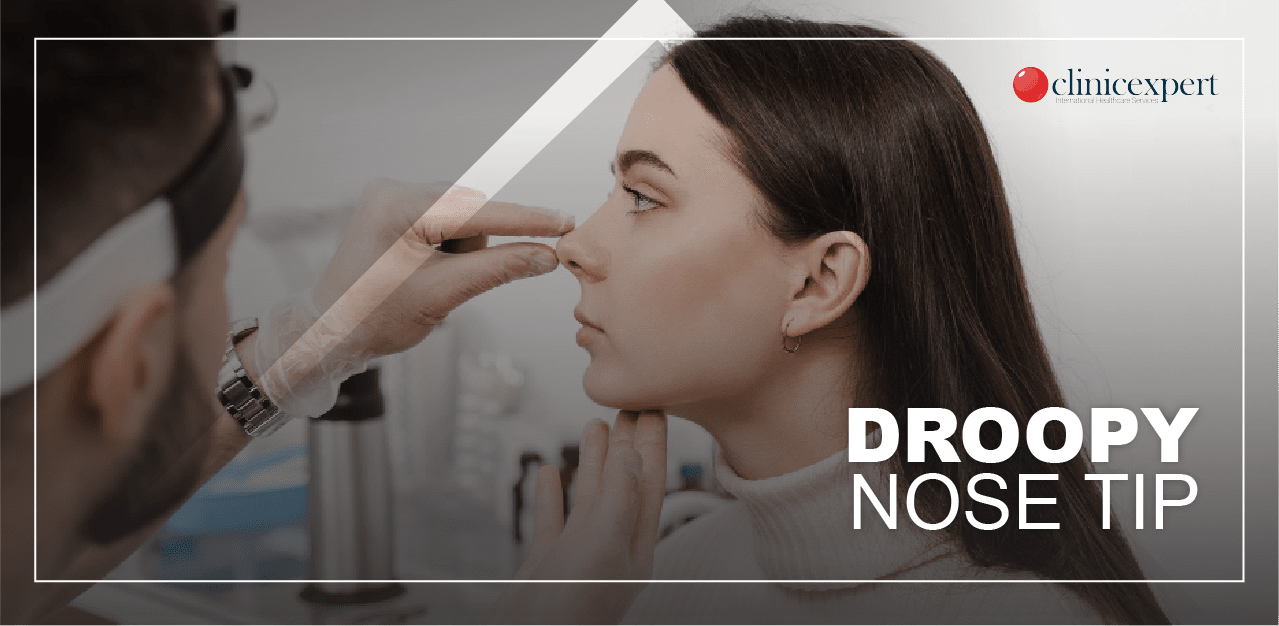Are you experiencing a downward-pointing or drooping tip of the nose, commonly referred to as a “droopy nose,”? Then, you may be interested in exploring options for nasal tip correction. Nasal tip, can be present from birth or may result from a previous rhinoplasty. One potential solution is the procedure of nasal tip rotation, which involves adjusting the angle of the nose tip to achieve a more desirable upward tilt.
What Is a Droopy Nose?
A droopy nose refers to a condition where the tip of the nose naturally points downward or appears to droop. When a person with a droopy nose smiles, the tip of their nose may further descend, exacerbating the drooping appearance. This condition is also known as nasal tip ptosis.
What Causes a Droopy Nose Tip?
The underlying causes of a droopy nose can vary and may involve different factors. Among these are weakened nasal support structures, inadequate healing after surgery, or other anatomical considerations.
When Does Drooping Start?
Nose drooping can have different onset times depending on the underlying cause. Here are a few scenarios:
Congenital
Some individuals are born with a droopy nose, which means the condition is present from birth. In these cases, the nose may exhibit a downward-pointing or drooping tip even during infancy.
Age-related changes
As we age, the supporting structures of the nose, such as the skin, cartilage, and ligaments, can gradually weaken or lose elasticity. This can lead to a drooping appearance of the nose over time. Age-related nose drooping is typically more common in older adults.
Previous rhinoplasty
In some cases, nose drooping may be a result of a previous rhinoplasty (nose surgery). Complications during healing or inadequate support provided during the initial procedure can contribute to nasal tip ptosis. This can occur at any point after the surgery, ranging from weeks to years later.
How to Correct Droopy Nose Tip When Smiling?
It’s important to note that nasal tip correction specifically aims to increase the angle between the upper lip and the bottom edge of the nose, providing a lifted appearance. Conversely, decreasing this angle would involve a nasal tip derotation, which is the reverse procedure.
While surgical rhinoplasty can produce dramatic and long-lasting results for correcting the slope and lifting the tip of the nose, it’s essential to understand that there is no one-size-fits-all approach. Various techniques exist for reconstructing the nasal tip, and finding a skilled and experienced surgeon who can tailor the procedure to your unique nose is crucial for achieving the best possible outcome.
So, if you’re seeking to address concerns related to a droopy nose tip, both when smiling and at rest, exploring options such as nasal tip rotation with a qualified surgeon could be a step towards achieving your desired aesthetic goals.
Droopy Nasal Tip Rhinoplasty
The impact of a droopy nose is often a cosmetic concern for individuals. That’s exactly why they seek to achieve a more aesthetically pleasing nasal appearance. Fortunately, there are surgical procedures available. A nasal tip rotation can help address this issue by adjusting the angle of the nose tip to a more desirable position. This intentional upward tipping of the nose increases the angle between the upper lip and the bottom edge of the nose, resulting in a lifted and more balanced appearance.
A key point to consider is that a droopy nose can have different causes and manifestations for each individual. So, consulting with a qualified surgeon is crucial to determine the most appropriate treatment plan based on the specific characteristics of the nose and the patient’s desired outcome. Contact us now for a free consultation.

